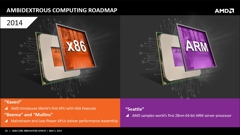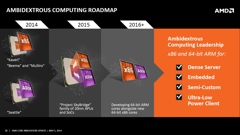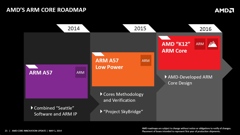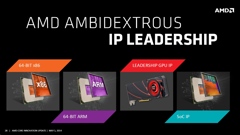
AMD (NYSE: AMD) presenta la sua nuova roadmap a breve e medio termine per quanto riguarda le soluzioni che sfrutteranno il meglio delle potenzialità offerte dagli ecosistemi x86 ed ARM, secondo la strategia denominata "ambidextrous computing". Il fondamento della nuova roadmap è costituito dall'annuncio della licenza per l'architettura ARM a 64 bit destinata allo sviluppo di prodotti ad alte prestazioni per nuovi segmenti di mercato a crescita elevata. L'annuncio di oggi rappresenta l'occasione per un'anteprima sui futuri piani di sviluppo di AMD nell'ambito della sua strategia "ambidestra", sia per il segmento computing che per quello delle soluzioni grafiche che, grazie ad un'infrastruttura flessibile e condivisa, è in grado di offrire ai propri clienti la possibilità di innovare nei settori embedded, server e client, così come per quanto riguarda le soluzioni semi-custom.
"Prima di oggi, AMD era la sola azienda al mondo a fornire soluzioni x86 ad alte prestazioni con consumi ridotti e performance grafiche leader nel settore. Ora, AMD compie un ulteriore passo in avanti, diventando l'unico produttore a offrire CPU ARM e x86 a 64 bit unite a una grafica di primo livello", dichiara Rory Read, AMD president e CEO. "La nostra innovativa capacità di progettare soluzioni ‘ambidestre', insieme alle nostre proprietà intellettuali e alla nostra esperienza nella realizzazione di SoC ad alte prestazioni dimostra che AMD è pronta a offrire prodotti che permettano ai nostri clienti di cambiare il mondo in modo più efficiente e significativo".
Il mercato dei processori ARM e x86 è destinato a crescere, superando gli 85 miliardi di dollari entro il 2017[i]. AMD si presenta quindi come la sola azienda in grado di offrire soluzioni differenziate per soddisfare le esigenze di un mercato così ampio. Per la prima volta, un produttore di processori ha a disposizione la proprietà intellettuale necessaria per spingere l'innovazione sia all'interno dell'ecosistema ARM che in quello x86.
La roadmap per la ‘strategia ambidestra per il computing' di AMD prevede:
- "Progetto SkyBridge" – disponibile a partire dal 2015, sarà caratterizzato da una nuova famiglia di APU e SoC a 20 nanometri, la prima al mondo con processori ARM e x86 "pin-compatible". Il modello ARM a 64-bit di "Project SkyBridge" sarà basato su core ARM Cortex-A57 e rappresenterà la prima piattaforma AMD per Android basata su architettura Heterogeneous System Architecture ("HSA"); la versione x86 sarà invece caratterizzata da un core "Puma+" di nuova generazione. La famiglia di processori "Project SkyBridge" offrirà inoltre una completa integrazione SoC, la tecnologia AMD Graphics Core Next, HSA e AMD Secure Technology con un processore Platform Security Processor (PSP) processore dedicato.
- "K12" – un nuovo core ARM ad alte prestazioni e consumo energetico ridotto che sfrutta i vantaggi garantiti dalla licenza ARM, l'esperienza di AMD nella creazione di soluzioni a 64 bit e la presenza di un team di sviluppo guidato da Jim Keller, ingegnere famoso per quanto riguarda la progettazione di semiconduttori. I primi prodotti basati su "K12" saranno presentati nel corso del 2016.
"In ARM lavoriamo con un gruppo di partner in grado di rivoluzionare e trasformare le esperienze in qualunque ambito, dai sensori ai server", afferma Simon Segars, CEO di ARM. "Grazie alla conoscenza del mercato di AMD e alla sua comprovata esperienza nella transizione verso soluzioni a 64 bit in ambienti client e server, combinate all'esperienza di ARM nello sviluppo di soluzioni a ridotto consumo energetico e nella realizzazione dell'architettura standard server base system (SBSA), saremo in grado di offrire nuove funzionalità e guideremo l'innovazione nei mercati con maggiore crescita".
AMD ha inoltre mostrato pubblicamente, per la prima volta, il suo processore a 64 bit AMD Opteron A-Series, nome in codice "Seattle", durante l'esecuzione di un ambiente Linux derivato dal Fedora Project. Il Fedora Project è una distribuzione Linux sponsorizzata da Red Hat che offre agli sviluppatori e agli amministratori IT di tutto il mondo un ambiente operativo di classe enterprise. Questo ambiente Linux basato su Fedora Project garantisce alle aziende la possibilità di passare a soluzioni server ARM senza la necessità di dover integrare da zero nuovi tool e nuove piattaforme software all'interno dei loro ambienti IT. Questa dimostrazione rappresenta quindi un ulteriore e significativo passo in avanti nell'introduzione dei processori ARM a 64 bit all'interno dei data center.

[Immagine ad alta risoluzione]

[Immagine ad alta risoluzione]

[Immagine ad alta risoluzione]

[Immagine ad alta risoluzione]

AMD (NYSE: AMD) today announced a roadmap of near- and mid-term computing solutions that harness the best characteristics of both the x86 and ARM ecosystems, called "ambidextrous computing." The cornerstone of this roadmap is the announcement of AMD's 64-bit ARM architecture license for the development of custom high-performance cores for high-growth markets. Today's announcement also provides a forward-looking glimpse into AMD's development plans to deliver truly unmatched ambidextrous computing and graphics performance using a shared, flexible infrastructure to enable its customers to blaze new paths of innovation for the embedded, server and client markets as well as semi-custom solutions.
"Before today, AMD was the only company in the world to deliver high performance and low-power x86 with leadership graphics. AMD now takes a bold step forward and has become the only company that can provide high-performance 64-bit ARM and x86 CPU cores paired with world-class graphics," said Rory Read, AMD president and CEO. "Our innovative ambidextrous design capability, combined with our portfolio of IP and expertise with high-performance SoCs, means that AMD is set to deliver ambidextrous solutions that enable our customers to change the world in more efficient and powerful ways."
The market for ARM- and x86-based processors is expected to grow to more than $85 billion by 20171 . AMD is uniquely positioned as the only company delivering differentiated solutions capable of addressing the breadth of this market. This is the first time a major processor provider has created the IP path to allow others to leverage innovation across both ARM and x86 ecosystems.
AMD's ambidextrous computing roadmap includes:
- "Project SkyBridge" – This design framework, available starting in 2015, will feature a new family of 20 nanometer APUs and SoCs that are expected to be the world's first pin-compatible ARM and x86 processors. The 64-bit ARM variant of "Project SkyBridge" will be based on the ARM Cortex-A57 core and is AMD's first Heterogeneous System Architecture ("HSA") platform for Android; the x86 variant will feature next-generation "Puma+" CPU cores. The "Project SkyBridge" family will feature full SoC integration, AMD Graphics Core Next technology, HSA, and AMD Secure Technology via a dedicated Platform Security Processor (PSP).
- "K12" – A new high-performance, low-power ARM-based core that takes deep advantage of AMD's ARM architectural license, extensive 64-bit design expertise, and a core development team led by Chief CPU Architect Jim Keller. The first products based on "K12" are planned for introduction in 2016.
"At ARM we are dedicated to working with partners who revolutionize and transform experiences everywhere from sensors to servers," said Simon Segars, CEO at ARM. "AMD's market reach and proven experience in leading industry transitions to 64-bit computing in client and server environments, combined with ARM's low power expertise and server base system architecture (SBSA) standard, will deliver new capabilities and drive innovation across multiple high growth markets."
AMD today also publicly demonstrated for the first time its 64-bit ARM-based AMD Opteron A-Series processor, codenamed "Seattle," running a Linux environment derived from the Fedora Project. The Fedora Project is a Red Hat-sponsored, community-driven Linux distribution, providing a familiar, enterprise class operating environment to developers and IT administrators worldwide. This Fedora Project-based Linux environment enables companies to transition to ARM-based servers without the need to integrate entirely new tools and software platforms to their IT environments. This demonstration represents a significant step forward in expanding the footprint of ultra-efficient 64-bit ARM processers within the data center.
News Source: AMD Press Release
Links
|

